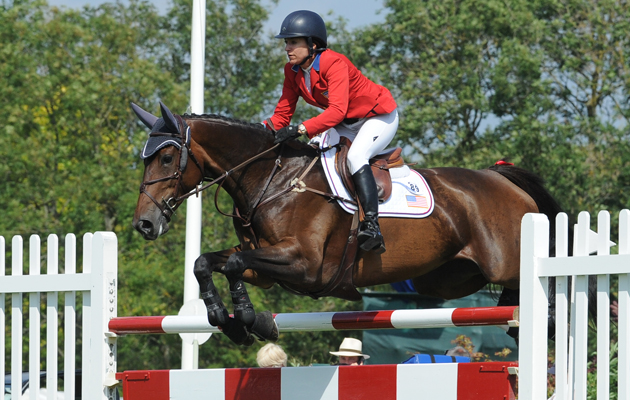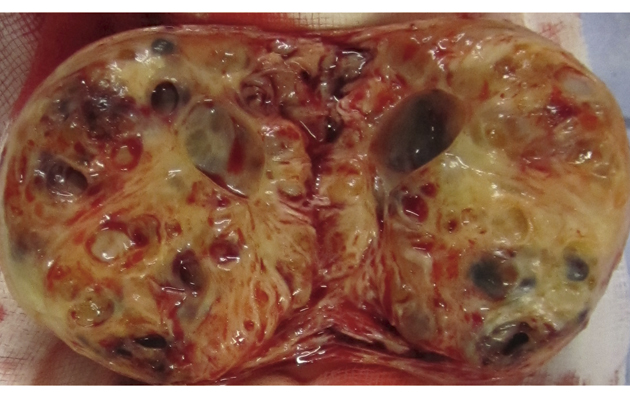Laura Kraut’s top showjumping mare Nouvelle (pictured below) was on good form on the international circuit last September when problems set in.
“She’s always been a little flighty and inconsistent, but she jumped brilliantly in Los Angeles,” says Laura, who has owned Nouvelle for four years, since the KWPN mare was seven.
“After a short break we took her to compete in Stuttgart, where she broke out in such a sweat that she was covered in white lather within minutes. She didn’t jump well, but when the vet examined her and could find nothing wrong we thought perhaps she had been upset by the atmosphere at the show.
“Two weeks later we went to Paris. The moment I got on her she started to sweat and after jumping one small round I knew something was wrong.”
Nouvelle returned to the US, where scans revealed she was suffering from ovarian cysts. She underwent surgery in January to have both ovaries removed.
“One ovary was misshapen and not at all healthy,” says Laura, who brought Nouvelle back to fitness in spring and scored a big win with the mare at Windsor in June.
“It has taken a bit of time for her to regain confidence, as she was anticipating pain, but she’s now so much more relaxed and has none of the nervousness and tension that has been present throughout her career.
“I think the cysts had been bothering her for a long time. You can see in her eyes that she’s happier.”

A common problem
Nouvelle’s condition is rare, but highlights the fact that ovary problems can produce a range of physical and behavioural issues.
Emma Houghton MRCVS explains that enlarged ovaries are seen frequently within equine practice, for a number of reasons.
“Enlargement may be due to tumours, or very occasionally ovarian cysts. More commonly they are found as a result of a problem with the release of an egg from the ovary. They may also be a normal finding during pregnancy,” she says.
According to Emma, the most common ovarian tumour is the granulosa cell tumour, or GCT (pictured below).
“GCTs account for 2.5% of all tumours seen in horses,” she explains. “They are slow growing, benign and usually unilateral — that is, affecting just one ovary. They can occur at all ages, although the average age is 10.
“These tumours cause an increase in various hormone levels. The resulting hormonal imbalance can profoundly affect the mare’s reproductive behaviour and personality.”

Signs that a GCT may be present include:
• Persistent, irregular or absent oestrus (the mare’s season).
• Aggressive, stallion-like behaviour. Affected mares may strike out or attempt to mount other mares in the field, and in long-term cases may develop excessive muscle and a cresty neck.
• Occasionally colic, if the tumour is especially large and causes tension on the ligaments attaching the ovary to the abdominal wall.
• Low-grade lameness in the performance horse, or other vague signs of discomfort such as irritability when being ridden.
Reaching a diagnosis
“Granulosa cell tumours can be identified by an ultrasound scan during a rectal examination,” says Emma. “They typically appear as an enlarged, multi-cystic, honeycomb-like structure and can reach up to 40cm in diameter. The other ovary is often small and inactive.”
Emma points out that there is significant variation in the appearance of granulosa cell tumours, so vets will usually recommend a blood test to differentiate the tumour from other possible diagnoses.
“The blood test is now very accurate,” she says. “We usually request the measurement of a panel of hormones within the blood, comprising the anti-müllerian hormone along with inhibin, testosterone and progesterone.
“Other ovarian tumours include cystadenomas and teratomas, although these are not normally hormonally active and therefore behaviour is not usually affected.”
Treatment involves surgical removal of the affected ovary, a procedure associated with a good prognosis.
“Surgical removal is recommended, especially in mares that are showing abnormal behavioural signs,” says Emma. “The procedure can normally be performed by flank laparoscopy [minimally invasive keyhole surgery], under standing sedation, allowing for a quick recovery time.
“Mares typically return to their normal cycling hormone patterns between six and 12 months after surgery,” adds Emma. “They can be bred from the following year, and studies show that 77% of mares can continue to produce live foals.”
Could they be cysts?
Less common ovarian abnormalities include the ovarian cysts that Nouvelle developed.
“These cysts arise from the developmental tissue of the ovary or surrounding structures,” says Emma. “They may be identified as a solitary cyst or as a cluster of multiple small cysts around or within the ovary.
“Cysts can be diagnosed by palpation of the ovary via the rectum, and are often described as a freely movable structure a short distance from the ovary. They do not typically have a detrimental effect on fertility, but larger cysts may interfere with early pregnancy transport into the uterus.
“The larger cysts may also cause signs of colic or low-grade lameness, as they can place pressure on the ligaments that suspend the ovary in the abdominal cavity.”
However, ovarian enlargement is not always related to or caused by disease, and may be discovered during routine ultrasonography of the reproductive tract.
“Persistent anovulatory follicles can occur when a mare fails to ovulate during her cycle,” says Emma, explaining that an ovulation abnormality can result in an egg remaining trapped in the follicular cavity. “Ovarian haematomas are another common reason for enlargement, developing from an ovulation where the collapsed follicle fills with blood.
“Pregnancy also causes bilateral [affecting both ovaries] enlargement due to the normal waves of follicular growth that occur during gestation.”
Although there may be no obvious outward signs, ovarian problems could be the cause of behaviour changes or loss of performance.
“Writing a diary for your mare to identify behavioural patterns can help your vet identify if something is wrong,” adds Emma.
Ref: Horse & Hound; 16 July 2015
